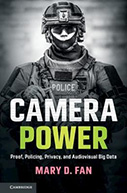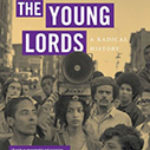Camera Power: Proof, Policing, Privacy, And Audiovisual Big Data

Author: Mary D. Fan
Publisher: New York: Cambridge University Press, 2019. 261p.
Reviewer: Keith Guzik | February 2021
Police body worn cameras entered the national consciousness in the United States in 2014 following the fatal police shooting of Michael Brown and subsequent protests and unrest in Ferguson, Missouri. Video-recording police interactions with the public was seen as a solution to the deep-rooted problem of police violence in the United States, which disproportionately affects people of color. The adoption of body camera systems was supported by anti-violence activists, advocacy groups, elected officials, federal judges, and police administrators, although police unions and some officers were less supportive. The massive protests across US cities in 2020 in response to the police killings of George Floyd in Minneapolis, Minnesota and Breonna Taylor in Louisville, Kentucky provided a stark reminder that body cameras have not appreciably curtailed police use of force (police killings in US continue to average around 1,000 per year) nor increased police accountability (few officers are charged when causing a death in the line of duty).
The public debate around police killings has shifted over the past six years. ‘Defund the police’ became a rallying cry for anti-violence activists and some municipal representatives, and reform efforts have focused more squarely on the political and legal structures believed to perpetuate police violence. Even as the federal government proved incapable of addressing the problem, hobbled by a head of state who encouraged officers to dismiss concerns about their conduct, state and local officials have passed an array of measures designed to reduce police use of force. These include banning choke holds and carotid holds as well as the use of teargas, pepper spray and rubber bullets on protesters, limiting qualified immunity as a defense for officers accused of misconduct, supporting the use of the early intervention systems (EIS) to identify problem officers earlier in their careers, requiring officer training in bias, de-escalation, and handling mental health situations, and creating new mental health teams to respond to crises in place of the police.
Body cameras remain a part of the conversation. Multiple states, including Colorado, New Hampshire, New York, and Rhode Island, have passed rules requiring their state police forces to adopt the technology. Washington D.C. now requires the release of body worn video for any police-involved death or major use of force within 3 days of the incident. And other municipalities have modified their policies around body worn cameras to ensure the recording of police-civilian contacts.
It is in this national context that Mary D. Fan’s Camera Power: Proof, Policing, Privacy, and Audiovisual Big Data (Cambridge University Press, 2019) makes an important contribution to the growing literature on body worn cameras. Fan is the Henry M. Jackson Professor of Law at the University of Washington, and her research takes a socio-legal approach to examine the impact of video technology on American policing. Drawing on a detailed analysis of body camera policy from over 200 agencies and over 100 interviews with police leaders and officers, copwatchers, community members, civil rights and civil liberties experts, industry leaders, and technologists, Camera Power situates the police’s adoption of body cameras within the larger recording revolution in contemporary society. Over the course of eight chapters, not including the introduction and conclusion, it considers a number of critical issues related to the technology, including privacy harms to both civilians and officers, police refusals to disclose data, the biased nature of audiovisual data, limits on the use and preservation of body camera video, and the evaluation and discipline of officers using the technology. The result is a richly detailed account of the variability, challenges, and potential benefits of body camera technology that should be required reading for political leaders, police administrators, and anti-violence activists interested in police reform.
The book’s main argument is clearly stated in the introduction and conclusion. To fully realize the potential of body cameras, policy needs to move beyond considering video solely for its evidentiary value and more fully embrace its potential for harm prevention. To make her case, Fan leverages her analysis of departmental policy to demonstrate the disparate nature of agencies’ approach to the technology. For example, roughly one-third of the 213 policies she examines make no provision on which types of law enforcement activities need to be recorded, inviting gaps in the police’s documentation of civilian contacts. Privacy is a major concern with body worn cameras, with civilians and officers subject to being captured at their most vulnerable moments. But policies vary widely in their privacy protections. Some states, including North Carolina and South Carolina, make broad exemptions from public disclosure of police body camera video, while others, such as Oklahoma and Indiana, seek to balance privacy with the public interest in accessing video by requiring the redaction of sensitive information. Departmental policy also differs in the use of recordings for supervisory purposes—20% of policies prohibit supervisors from accessing officers’ videos unless a complaint has been filed, while 21% require supervisors to regularly review videos to ensure compliance with recording and other departmental procedures. This variability in the policies governing body cameras might not be surprising, considering the decentralized organization of policing in the United States. But the impacts of video-recording technology cannot be expected to be uniform when the policies dictating their use are so mixed.
The unpredictable outcomes of body camera technology are also reflected in the subjective nature of video, the subject of Camera Power’s fascinating fifth chapter, “How Data Can Mislead.” There, Fan recounts the story of George Powell III, who was convicted and imprisoned in Texas for a series of convenience store robberies despite the fact that he stands 6’3’’ and the suspect caught on camera was estimated to be 5’7’’. The story demonstrates how technical considerations limit the evidentiary value of video. Two-dimensional videos lack the parallax required for depth perception, which makes determining something as basic as a person’s height difficult. Camera angles matter too—viewers are more likely to believe a confession was coerced if the camera is pointed at the detective, for instance. Facial recognition technology has also been shown to be racially biased, as it misidentifies darker-skinned females one-third of the time.
Camera Power thus adds to a growing literature highlighting the limitations of body camera technology. But Fan’s work sets itself apart by offering up a number of innovative ideas for moving policy forward. For instance, video recordings could be pooled together and analyzed using neural networks to detect the types of situations most commonly leading to excessive use of force or civilian complaints and to support EIS identifying problem officers. Community member video could also be stored in independent repositories to provide additional data points for understanding police interactions. In other words, in Fan’s view, the problems hampering police body cameras will not be solved by limiting the amount of video produced, but by increasing it and more systematically analyzing it using machine learning and artificial intelligence.
Endorsing the increased recording and analysis of law enforcement activities bumps up against privacy concerns. Attentive to this dilemma, Fan cleverly looks beyond policing to understand how other fields have successfully managed databases containing sensitive information. An independent, public repository of body camera video, for instance, could be modeled on the Aviation Safety Reporting System (ASRS), the world’s largest data repository on human factors in flight incidents, which is managed by NASA to eliminate conflicts of interest within the aviation industry. Aggregated data, meanwhile, could be analyzed by researchers while preserving privacy by following standards used in the health sciences, where access to data is limited to those with clearly stated research goals and privacy protection plans explaining how sensitive information will be stored and protected. Regarding the excessive costs of redacting videos to comply with privacy protections, safe harbors could be established, as was done with the development of the Internet, to encourage advances in redaction technology. Finally, the United Kingdom, which has also adopted police body cameras on a wide scale, offers insights on how to set policy to protect privacy. Mandating continuous recording is too insensitive to the plights of certain victims, officials should have the discretion to decline video access requests from individuals not involved in a case, and redaction is needed to enable public disclosure while respecting privacy.
Another challenge associated with body camera technology has been the failure of officers to activate their recording devices, whether due to the pressures of responding to stressful calls or intentional efforts to elude documentation. On this matter, Fan wisely notes that “Internal departmental enforcement of recording rules is challenging because of the individual fault-based nature of disciplinary process and management-labor negotiations and protections”. As a result, “judicial remedies are especially important” (234). Courts can incentivize recording by excluding partial recordings or adopting a “favorable inference” that missing video would have supported the defense in a criminal matter.
No book is able to cover every angle on a given topic, especially one as broad as the adoption of a new technology by an organization as varied and pervasive in society as police agencies. But as a sociologist, I wanted to see Camera Power dedicate more attention to certain questions and dilemmas implicit within its findings and proposals. For example, one of the main takeaways from the book is how greatly departments vary in their policies. One wonders what explains this variation. Is it police leadership, organizational culture, the communities these departments serve, or the political settings in which they operate? Knowing this is central to better understanding the amenability of departments to the types of changes outlined in the book. Similarly, one wonders whether policy differences correlate with variation in use of force. Knowing that would underscore the importance of policy in regulating the technology. And for a book investigating police agencies’ adoption of technology in response to public concerns about use of force against racial and ethnic minorities, Camera Power says little about race relations in the US or the inflexibility of police organizations to reform. Put differently, on what basis can police agencies be expected to alter their established ways of doing things?
These points aside, Mary D. Fan has contributed an important piece of research that can serve as a vital resource for politicians, police departments, technology firms, and researchers interested in reforming American policing. Whether these proposals and others like them are taken up and adhered to will go a long way in indicating the earnestness of political leaders and police administrators in disrupting cycles of state violence and impunity that have disintegrated trust in the police in communities across the country.
Keith Guzik, Associate Professor of Sociology, University of Colorado Denver


